Making Wishes |
||||||||||
 |
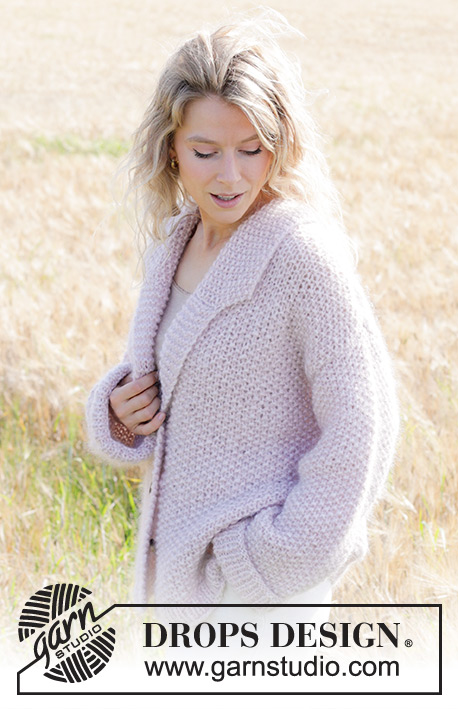 |
|||||||||
Knitted oversized jacket in 1 strand DROPS Air and 2 strands DROPS Kid-Silk. The piece is worked bottom up with moss stitch, a collar and sewn-in sleeves. Sizes XS - XXL.
DROPS 248-33 |
||||||||||
|
------------------------------------------------------- EXPLANATIONS FOR THE PATTERN: ------------------------------------------------------- GARTER STITCH (worked back and forth): Knit all rows, from both the right and wrong side. 1 ridge in height = knit 2 rows. PATTERN: See diagrams A.1 and A.2. The diagrams show all rows in the pattern from the right side. INCREASE TIP-1 (for bands): Increase 1 stitch mid-front by making 1 yarn over inside the band. On the next row knit the yarn over twisted to avoid a hole. INCREASE TIP-2 (for sleeves): Increase 1 stitch on each side by making 1 yarn over, inside the 1 garter stitch. On the next row knit the yarn over twisted to avoid a hole. Then work the new stitches into A.1. BUTTONHOLES: Work the buttonholes on the right band. 1 BUTTONHOLE = knit together the 3rd and 4th stitch from the edge, make 1 yarn over. On the next row knit the yarn over to leave a hole. Work the buttonholes when the piece measures XS: 15, 23, 31 cm = 6", 9", 12¼" S: 15, 24, 33 cm = 6", 9½", 13" M: 15, 23, 31 cm = 6", 9", 12¼" L: 15, 24, 33 cm = 6", 9½", 13" XL: 16, 26, 36 cm = 6¼", 10¼", 14¼" XXL: 18, 28, 38 cm = 7", 11", 15" ------------------------------------------------------- START THE PIECE HERE: ------------------------------------------------------- JACKET – SHORT OVERVIEW OF THE PIECE. The piece is worked back and forth with circular needle, bottom up. The front and back pieces and the sleeves are worked separately, then sewn together. Stitches are knitted up along the neckline and the collar worked back and forth, then sewn to the bands on each side. BACK PIECE: Cast on 71-75-83-89-97-101 stitches with circular needle size 6 MM = US 10, 1 strand DROPS Air and 2 strands DROPS Kid-Silk (= 3 strands). Purl 1 row from the wrong side. Work as follows from the right side: 1 GARTER STITCH – read description above, work rib (knit 1, purl 1) until there are 2 stitches left, knit 1 and 1 garter stitch. Continue this rib for 4-4-4-4-5-5 cm = 1½"-1½"-1½"-1½"-2"-2". Change to circular needle size 8 MM = US 11. Work PATTERN – read description above, as follows from the right side: 1 garter stitch, work A.1 until there is 1 stitch left, decreasing at the same time 10-10-12-12-14-14 stitches evenly spaced, 1 garter stitch = 61-65-71-77-83-87 stitches. Continue pattern, with 1 garter stitch on each side. REMEMBER THE KNITTING GAUGE! When the piece measures 41-42-43-44-45-46 cm = 16⅛"-16½"-17"-17¼"-17¾"-18", bind off 2-2-4-4-6-6 stitches for the armholes at the beginning of the next 2 rows = 57-61-63-69-71-75 stitches. Continue A.1 with 1 garter stitch on each side, until the piece measures 60-62-64-66-68-70 cm = 23⅝"-24⅜"-25¼"-26"-26¾"-27½". OVERVIEW OF NEXT SECTION: Insert 1 marker in the middle stitch on the row (= mid-back). This is used when working the neckline. You now place stitches on threads for the diagonal shoulders and bind off for the neckline. Read DIAGONAL SHOULDERS and NECKLINE before continuing. DIAGONAL SHOULDERS: Place stitches on a thread at the beginning of each row on both sides as follows: 5-5-5-6-6-7 stitches on the thread 3 times on each side, then the next 8-9-10-10-10-9 stitches towards the neck (=23-24-25-28-28-30 stitches on the threads each side). NECKLINE: At the same time, when the piece measures 62-64-66-68-70-72 cm = 24⅜"-25¼"-26"-26¾"-27½"-28⅜", bind off the middle 9-11-11-11-13-13 stitches for the neckline (= marker-stitch + 4-5-5-5-6-6 stitches on each side). Continue as before and bind off 1 stitch on the next row from the neck. When all the stitches are on threads or bind off for the neckline, the piece measures 64-66-68-70-72-74 cm = 25¼"-26"-26¾"-27½"-28⅜"-29⅛" from the cast-on edge at the top of the shoulder. Place the 23-24-25-28-28-30 stitches from the thread on one side back on circular needle size 8 MM = US 11 and work 1 row stockinette stitch; to avoid holes in the transitions between the sets of stitches, pick up the loop before the next stitch on the left needle and place it twisted on the left needle. Work together this loop with the next stitch on the left needle. Bind off. Work the other shoulder in the same way. RIGHT FRONT PIECE: Cast on 42-44-48-50-54-56 stitches with circular needle size 6 MM = US 10, 1 strand DROPS Air and 2 strands DROPS Kid-Silk (= 3 strands). Purl 1 row from the wrong side. Work as follows from the right side: 7 garter stitches (= band), work rib (knit 1, purl 1) until there is 1 stitch left, 1 garter stitch. Continue this rib for 4-4-4-4-5-5 cm = 1½"-1½"-1½"-1½"-2"-2". Change to circular needle size 8 MM = US 11 and work pattern as follows from the right side: 7 garter stitches, work A.1 until there is 1 stitch left and decrease 6-6-6-6-6-6 stitches evenly spaced, 1 garter stitch = 36-38-42-44-48-50 stitches. Continue the pattern with 7 garter stitches mid-front and 1 garter stitch at the side. When the piece measures 15-15-15-15-16-18 cm = 6"-6"-6"-6"-6¼"-7", start to work BUTTONHOLES – read description above. When you have worked 1 cm = ⅜" after the last buttonhole (the piece measures approx. 32-34-32-34-37-39 cm = 12½"-13⅜"-12½"-13⅜"-14½"-15¼"), increase the number of garter stitches in the band mid-front (which becomes wider) as follows: Increase 1 stitch inside the band – read INCREASE TIP-1, every 8th-8th-8th-8th-6th-6th row 6-6-7-7-8-8 times; each increase is on the outside of the already increased stitches (away from the 7 band stitches). AT THE SAME TIME, when the piece measures 41-42-43-44-45-46 cm = 16⅛"-16½"-17"-17¼"-17¾"-18", bind off 2-2-4-4-6-6 stitches for the armhole at the beginning of the next row from the side. When the piece measures 54-56-58-60-61-62 cm = 21¼"-22"-22¾"-23⅝"-24"-24⅜" from the cast-on edge and the band-increases are finished, place the outermost 13-13-14-14-15-15 stitches mid-front on a thread (these stitches are later sewn to the collar) = 27-29-31-33-35-37 stitches on the front piece. Insert 1 marker in the first stitch on the row, by the neck, which is used when knitting up stitches for the collar. Continue working and bind off for the neckline at the beginning of each row from the neck as follows: 2 stitches 1-1-1-1-2-2 times and 1 stitch 2-3-4-3-3-3 times = 23-24-25-28-28-30 stitches. When the piece measures 60-62-64-66-68-70 cm = 23⅝"-24⅜"-25¼"-26"-26¾"-27½", place stitches on a thread for the diagonal shoulder. DIAGONAL SHOULDER: Place stitches on a thread at the beginning of each row from the side as follows: 5-5-5-6-6-7 stitches on the thread 3 times = 8-9-10-10-10-9 stitches left by the neck. Place the 15-15-15-18-18-21 stitches from the thread back on needle size 8 MM = US 11 (= 23-24-25-28-28-30 stitches), work 1 row stockinette stitch; to avoid holes in the transitions between the sets of stitches, pick up the loop before the next stitch on the left needle and place it twisted on the left needle. Work together this loop with the next stitch on the left needle. Bind off. LEFT FRONT PIECE: Cast on 42-44-48-50-54-56 stitches with circular needle size 6 MM = US 10, 1 strand DROPS Air and 2 strands DROPS Kid-Silk (= 3 strands). Purl 1 row from the wrong side. Work as follows from the right side: 1 garter stitch, work rib (knit 1, purl 1) until there are 7 stitches left, 7 garter stitches (= band). Continue this rib for 4-4-4-4-5-5 cm = 1½"-1½"-1½"-1½"-2"-2". Change to circular needle size 8 MM = US 11 and work pattern as follows from the right side: 1 garter stitch, work A.2 until there are 7 stitches left and decrease 6-6-6-6-6-6 stitches evenly spaced, 7 garter stitches = 36-38-42-44-48-50 stitches. Continue the pattern with 1 garter stitch at the side and 7 garter stitches mid-front. When the piece measures 32-34-32-34-37-39 cm = 12½"-13⅜"-12½"-13⅜"-14½"-15¼" (match the length to the right front piece), increase the number of garter stitches in the band mid-front (which becomes wider) as follows: Increase 1 stitch inside the band – remember INCREASE TIP-1, every 8th-8th-8th-8th-6th-6th row 6-6-7-7-8-8 times; each increase is on the outside of the already increased stitches (away from the 7 band stitches). AT THE SAME TIME, when the piece measures 41-42-43-44-45-46 cm = 16⅛"-16½"-17"-17¼"-17¾"-18", bind off 2-2-4-4-6-6 stitches for the armhole at the beginning of the next row from the side. When the piece measures 54-56-58-60-61-62 cm = 21¼"-22"-22¾"-23⅝"-24"-24⅜" from the cast-on edge and the band-increases are finished, place the outermost 13-13-14-14-15-15 stitches mid-front on a thread (these stitches are later sewn to the collar) = 27-29-31-33-35-37 stitches on the front piece. Insert 1 marker in the last stitch on the row, by the neck, which is used when knitting up stitches for the collar. Continue working and bind off for the neckline at the beginning of each row from the neck as follows: 2 stitches 1-1-1-1-2-2 times and 1 stitch 2-3-4-3-3-3 times = 23-24-25-28-28-30 stitches. When the piece measures 60-62-64-66-68-70 cm = 23⅝"-24⅜"-25¼"-26"-26¾"-27½", place stitches on a thread for the diagonal shoulder. DIAGONAL SHOULDER: Place stitches on a thread at the beginning of each row from the side as follows: 5-5-5-6-6-7 stitches on the thread 3 times = 8-9-10-10-10-9 stitches left by the neck. Place the 15-15-15-18-18-21 stitches from the thread back on needle size 8 MM = US 11 (= 23-24-25-28-28-30 stitches), work 1 row stockinette stitch; to avoid holes in the transitions between the sets of stitches, pick up the loop before the next stitch on the left needle and place it twisted on the left needle. Work together this loop with the next stitch on the left needle. Bind off. SLEEVES: Cast on 38-40-42-42-44-44 stitches with circular needle size 6 MM = US 10, 1 strand DROPS Air and 2 strands DROPS Kid-Silk (= 3 strands). Purl 1 row from the wrong side. Work as follows from the right side: 1 garter stitch, work rib (knit 1, purl 1) until there is 1 stitch left, 1 garter stitch. Continue this rib for 6-6-6-6-8-8 cm = 2⅜"-2⅜"-2⅜"-2⅜"-3⅛"-3⅛". Change to circular needle size 8 MM = US 11. Work pattern with the first row from the right side as follows: 1 garter stitch, work A.1 until there is 1 stitch left and decrease 6-6-6-6-6-6 stitches evenly spaced, 1 garter stitch = 32-34-36-36-38-38 stitches. Continue the pattern with 1 garter stitch on each side. When the piece measures 8-8-8-8-10-10 cm = 3⅛"-3⅛"-3⅛"-3⅛"-4"-4", increase 1 stitch on each side – read INCREASE TIP-2. Increase like this every 7-7-6½-5-4½-4 cm = 2¾"-2¾"-2½"-2"-1⅝"-1½" a total of 6-6-6-7-7-8 times = 44-46-48-50-52-54 stitches. Work until the sleeve measures 47-46-44-42-41-40 cm = 18½"-18"-17¼"-16½"-16⅛"-15¾", or to desired length before the sleeve cap (which measures 2-2-4-4-5-5 cm = ¾"-¾"-1½"-1½"-2"-2"). Insert 1 marker in each side – mark the bottom of the armhole and they are used when sewing in the sleeve. Work a further 2-2-4-4-5-5 cm = ¾"-¾"-1½"-1½"-2"-2" from the markers, the sleeve measures approx. 49-48-48-46-46-45 cm = 19¼"-19"-19"-18"-18"-17¾" from the cast-on edge. Bind off. ASSEMBLY: Sew the shoulder seams. Sew the side seams inside 1 garter stitch. Sew the sleeve seams from the cuff to the marker (= a split of approx. 2-2-4-4-5-5 cm = ¾"-¾"-1½"-1½"-2"-2" at top of sleeve). Sew the sleeve cap to the armhole, inside 1 garter stitch. Sew the split at the top of the sleeve to the bottom of the armhole – see sketch. COLLAR: Use circular needle size 8 MM = US 11, 1 strand DROPS Air and 2 strands DROPS Kid-Silk (= 3 strands). Start from the wrong side by the marker on the left front piece and knit up 35-37-37-37-43-43 stitches along the neckline as far as the marker on the right front piece. Work A.1 back and forth over all stitches until the collar measures 14-14-15-15-16-16 cm = 5½"-5½"-6"-6"-6¼"-6¼". Bind off a little loosely with rib. Use grafting stitch and sew the stitches from the thread to the right band – sew 1 stitch from the band to 1 row in height on the collar. Sew in the same way on the other front piece. |
||||||||||
Diagram explanations |
||||||||||
|
||||||||||

|
||||||||||

|
||||||||||
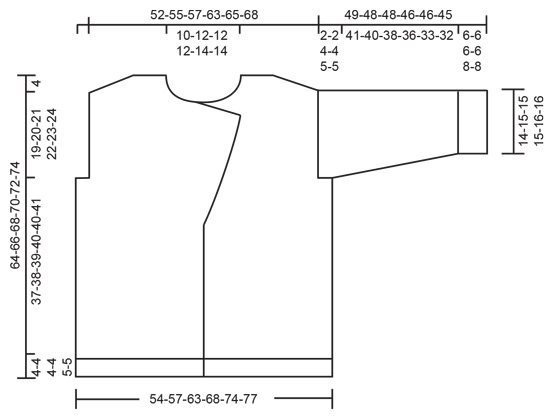
|
||||||||||
|
Have you made this or any other of our designs? Tag your pictures in social media with #dropsdesign so we can see them! Do you need help with this pattern?You'll find tutorial videos, a Comments/Questions area and more by visiting the pattern on garnstudio.com. © 1982-2024 DROPS Design A/S. We reserve all rights. This document, including all its sub-sections, has copyrights. Read more about what you can do with our patterns at the bottom of each pattern on our site. |
||||||||||







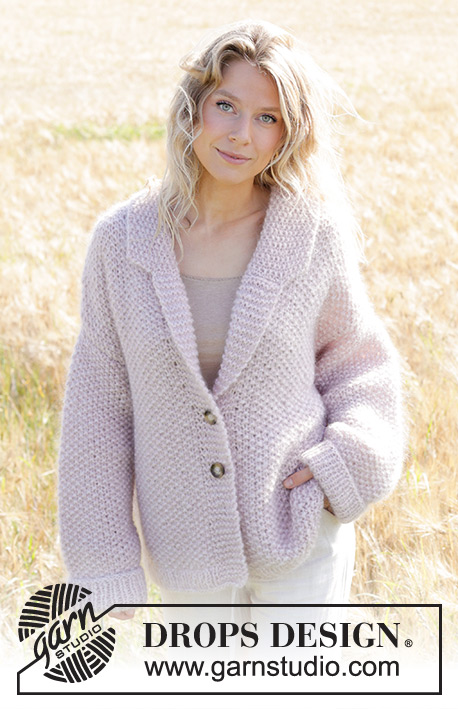


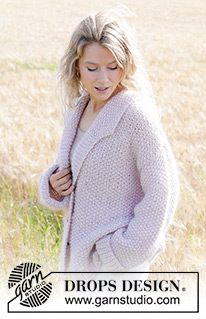
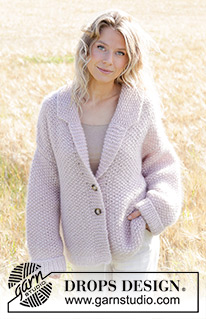






























































Comments / Questions (10)
Gisteravond het vest afgemaakt, prachtig! Ik brei helemaal “op maat” in dit geval mt L en ik heb 7 bollen Air gebruikt en 10 bolletjes Kid Silk en hield nog ruim 25 gr over van de laatste gebruikte bollen! Heerlijke wol, mooie combi😉👍
03.04.2024 - 08:52Ik zou graag deze vest willen breien in maat xxl Hoeveel bolletjes garen heb ik dan nodig Dank u
08.03.2024 - 20:20DROPS Design answered:
Dag Cindy,
De hoeveelheid benodigde garens staat aangegeven bovenaan bij de materialen. De reeks getallen slaat op de maten, dus voor xxl neem je het laatste getal. Een bol Air weegt 50 gram en een bol Kid-Silk weegt 25 gram.
10.03.2024 - 10:20Superbe veste pour l'automne. J'adore.
22.01.2024 - 10:15Chic
21.01.2024 - 13:22Spring bubbles
19.01.2024 - 09:58Hygge on a fall day
19.01.2024 - 05:51Friend
18.01.2024 - 21:55Cozy
18.01.2024 - 21:54Airlight
18.01.2024 - 18:16Voilà une superbe veste qui tiendra bien chaud ! Elle a l'air très douce.
18.01.2024 - 13:22